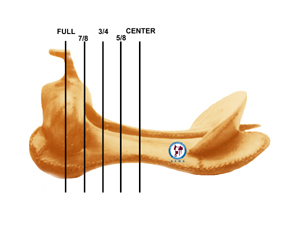THE SADDLE
The saddle has two sub-elements: the tree and saddle design and construction.
|
The saddle tree is one of the primary elements or variables in saddle fit. The bars are the primary element of the tree along with swell gullet width and height as to saddle fit.
The tree bars have contact with the horse and are designed to distribute rider's weight evenly over the horse's back. The tree bars have their own set of variables. Those being; angle, twist, rock, flare, crown, relief, length, pattern and channel. Of these variables the angle is the most important.
If the angle is incorrect none of the other measurements or padding can compensate for or correct a negative fit.
( CLICK HERE for details)
|
The bar angle is the defining element of the tree as to saddle fit with swell gullet width, twist, rock, flare, crown, relief, length, pattern and channel as secondary elements. The bar angle is designed to correspond to the profile or slope of the “saddle pocket” on a horse located below the withers and back of the shoulder blade. This angle is described in the generic terms of: quarter horse bars, full quarter horse bars, semi-quarter horse bars. Tree makers express this angle in degrees and is calculated by a geometric and mathematical formula. The higher number in degrees the flatter the angle.
There is a lot of confusion, and misconceptions here, due to definitions and use of words, such as wide, narrow, etc. For more detailed discussion CLICK HERE
While the generic terms of Quarter horse bars, full quarter horse bars, semi-quarter horse bars have worked in the past, the landscape has changed and is changing. New bloodlines have been introduced into the Quarter horse breed along with selective breeding and cross breeding giving more diversity in the conformation of the Quarter horse, thus limiting these generic descriptions. Also, over time these terms have been modified and mis-interpreted which has lead to mis-leading and contradictory information. For example:
“Generally, Semi-QH bars are made for horses with more sloped sides and not so wide backs. A semi-QH tree is supposed to fit horses with a more TB or narrow build.”
“Semi-Quarter Horse Bars - horses got bigger and wider from the 1970's on, requiring a wider angle in the bars. Semi-quarter horse bars fit most of today’s western horses.”
These quotes were brought to our attention and taken from two very popular web sites that discuss saddle fit. As you can see they contradict each other. Upon further research we found additional sites that also contained wide ranging mis-leading and contradictory information. Given this, ASMA is of the opinion these descriptions are no longer viable due to the mis-leading and contradictory information .
As stated before tree makers express this angle in degrees , such as 90, 93, and 95. Each tree maker has developed his or her own version of the geometric and mathematical formula calculation for the bar angle to meet their construction techniques, so there can be a variance between tree makers. Quote from a well know saddle maker. “One makers 90 degree with a 6 " gullet can fit the same as another makers 93 degree withe a 61/2" gullet.”. Again, given this, ASMA is of the opinion these descriptions are not meaningful due to the noted variances.
Therefore, ASMA recommends the following:
That the “historical” terms Quarter horse bars, full quarter horse bars, semi-quarter horse bars not be used. Nor should the angle be expressed in degrees of the angle. The slope or angle of the “saddle pocket” on a horse located below the withers and back of the shoulder blade be described as a body type or profile.
There are two basic body types or profiles: upright or steep and flat or spread out.

|
The bar angle is based on the slope of the saddle pocket below the wither. The horse's back changes angles moving back towards the hip from the wither. Moving along the back from the wither, the back becomes flatter (see FIGURE 1). Therefore, moving back along the bar from the swell, the bar needs to become flatter to match the horse's back (see FIGURE 2 and Exhibit A). This is known as twist.
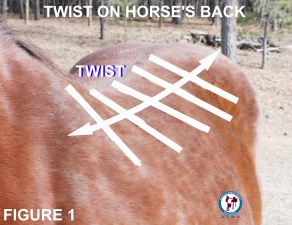 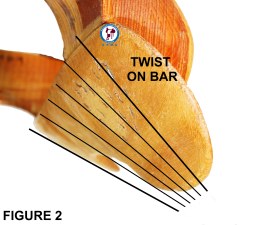  If the bar angle and twist do not match the horse's back, then a negative fit will be the result. If the tree bars have full contact with the horse's back then the fit is positive (see FIGURE 3). If the twist is to steep the bottom of the bars will dig into the horse's back causing pressure points for a negative fit (see FIGURE 4 and exhibit A). When the twist is to flat there will be pressure points at the top of the bars giving a negative fit (see FIGURE and exhibit B).
  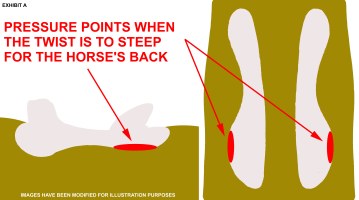 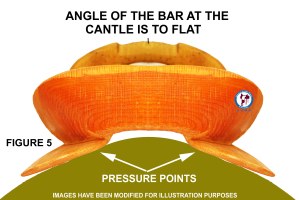 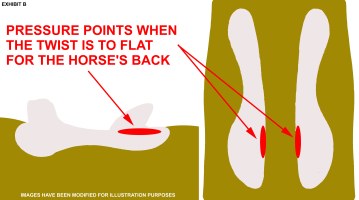 |
The rock (see FIGURE 1) in the bars of the tree are designed to conform the curvature of the horse's back or top line (see FIGURE 2). NOTE: The actual rock measurement is taken on the horse's side approximately 3" to 4" down from the center of the back bone as indicated by the white arrow in FIGURE 2.
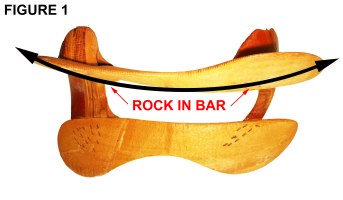  For the saddle to have a positive fit, the rock in the tree bars must match the contour of the horse's back or the fit will be negative (see exhibit A).
 If the rock in the bars is to "flat", the saddle will "bridge" as indicated in exhibits B and B-1. When a saddle bridges only the ends of the tree bars have contact with the horse's back. The bars are designed to distribute the load vector or rider's weight evenly over the entire length of the bar. If the saddle is bridging, the result is all the load vector is transferred to four points at the ends of the bars. Depending upon the degree of bridging, the level of positive fit will be decreased or may result in a negative fit.
  If the rock in the bars is too "round", the saddle will 'rock" as demonstrated in exhibits C and C-1. If a saddle rocks ( like a rocking chair), only the center portion of the bars have contact with the horse. Again, the bars are designed to distribute the load vector or rider's weight evenly over the entire length of the bar. With the saddle rocking the load vector is concentrated in the center of the bars. As with bridging, depending upon the degree of rock, the level of positive fit will be decreased or could result in a negative fit.
 
|
 The elements of a saddle tree are inter-related and there are sub-sets of sub-sets; bar flare is one of them. Bar flare is a good example and can be considered as part of bar rock, bar twist, bar pattern, or swell pattern depending on one's point of view. The bar flare is the curve in the bar from POINT A to the front tip of the bar as illustrated in FIGURE 1. The more flare in the bar the wider the tips of the bar will be as indicated in FIGURE 2.
 When a horse has predominate shoulders (as with gaited horses) a tree with not enough bar flare can interfere with the shoulder causing a pressure point and thus a decreased level of positive saddle fit
(see exhibit A ). A tree with more bar flare will allow more room for the movement of the shoulder of a horse with a predominate shoulder and result in a higher level of positive saddle fit.
 |
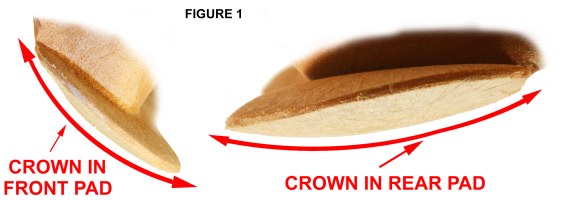 In addition to bar angle, rock and twist, the bottom of the bar next to the horse has crown. The crown in both the front pad of the bar and back pad of the bar (see FIGURE 1) is designed to "fill-in" the profile and contour of the horse's back.
 The crown in the front pad of the bar is designed to "fill-in" the saddle pocket as shown in FIGURE 2, which indicates a good fit.
 If the saddle pocket on the horse is flat and the front bar pad has to much crown then there will be a pressure point at the bottom of the crown (as depicted in FIGURE 3 and exhibit A) resulting in a negative fit.
NOTE: It has been observed there is a trend in conformation to a flatter saddle pocket and therefore less crown is needed in the bar.
 When there is not enough crown in the front pad and the saddle pocket has more contour, there will be pressure points (illustrated in FIGURE 4 and exhibit B) again resulting in a negative fit.
 The rear bar pad also has a crown although not as pronounced as the crown in the front pad (see FIGURE 5). Unlike a flat front bar pad, a flat rear pad does not appear the be a problem generally, but could present a problem in a horse with an abnormal conformation.
 If the rear bar pad has to much crown then the result will be a pressure point at the bottom of the crown (as depicted in FIGURE 6 and exhibit C) with a resulting negative fit.
|
 Bar relief is the curve or roll at the front and back edges of the bars (see FIGURE 1). Well designed bars are designed with a bar relief to accommodate the motion of a horse’s shoulder and hip. The relief allows the bars to "ride" with the movement of the horse like the turned up tips of snow or water skis allow the skier to "ride" the snow or water without the ski tips digging in. If the bar does not have enough relief, the front of the bar can dig in to the shoulder and the rear of the bar can dig into the hip restricting the movement of the horse and possibly cause a sore spot (see exhibit A) and the consequence is a negative fit. Depending upon the situation, both the front and back could be affected or just the front or just the back individually.
 |
The bar length is the overall length of the bar from tip to tip ( see exhibit A). Again if the bar rock and twist are correct the bar length should not be a problem in saddle fit except for a short bar in which the load bearing area will be reduced
(see exhibit A-1) or when the bar tips are to short or to long.
   FRONT BAR TIP
For the horse with a well developed or predominate shoulder, a tree with a long bar tip may cause the bar to dig in to the shoulder creating a pressure point and inhibiting the movement of the shoulder effecting the stride or gait of the horse
(see exhibit B). This is a common problem area for the gaited horses. Also, the movement of the shoulder can cause the saddle to be pushed back out of the proper position resulting in a decreased level of fit.
REAR BAR TIP
In general the length of the rear bar tip should not be a problem except
when the tip is abnormally short. A tree with abnormally short rear bar
tips may dig onto the loins of the horse (see exhibit C).
 For the short For the short backed horse, the rear bar tip may lose contact with the horse's back and reduce the bearing surface for the bars (see exhibit D ) and result will be decreased level if fit.
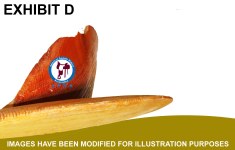 |
 The bar pattern is the basic shape of the bar. The bar pattern will vary as to the design and intended use of the tree. For Example: a tree designed for roping will have a bar shape or pattern different from a tree designed for cutting. See below for examples. The bar pattern is the basic shape of the bar. The bar pattern will vary as to the design and intended use of the tree. For Example: a tree designed for roping will have a bar shape or pattern different from a tree designed for cutting. See below for examples.  Generally the bar pattern has little effect on saddle fit, except for the stirrup leather slot or channel. If the bar does not have a stirrup leather slot or the slot is too shallow (see exhibit A), then the stirrup leather will stand proud create a ridge or bump that can cause pressure points (see exhibit B) and therefore decrease the level of positive saddle fit.
  |
 With the bar angle being the defining element of the tree as to saddle fit the other major measurement is the bar channel. The bar channel is the area created between the bars where the bars are attached to the swell and cantle.
( See Point A in EXHIBIT A ) and cantle (See Point B in EXHIBIT A ). The bar channel or hand hold width along with the other elements determine the end-result gullet width. It also, provides clearance or relief for the backbone of the horse.
|
The "gullet" or "swell gullet" is the area under the swell (also referred to as the pommel or fork) that provides clearance for the withers of the horse (see Exhibit A). Generally this area is referred to as the "gullet". The gullet is probably the most mis-understood and mis-used term used in the saddlery industry by both riders and saddlemakers. The gullet is multi-dimensional and is the end result of several factors
(see FIGURE 1).

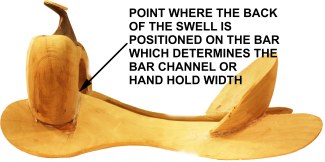 With the gullet width being the end result of several measurements there are situations where this end-result can cause confusion and mis-interpretation. The bar channel or hand hold width measurement (the point where the back of the swell is positioned on the bar) is basically the measurement that determines the width between the bars.
 From this point the bars flare out. The amount of flare will affect the end-result of the gullet width with the bar channel width unchanged as indicated in the example at the right. The more flare in the bar pattern will create a wider gullet width. For example, using a bar channel width of 4" with a flare indicated by the blue line the
end-result gullet width is 6 1/4", while the flare indicated by the red line yields an end-result gullet width of 6 ½". Therefore, if two identical trees are made except one has bar flare A and one has bar flare B, they will fit differently. One tree could have a negative fit while the other has a positive fit or both trees are within the positive fit tolerances.
 If one wanted the end-result gullet width of two trees with different flare patterns to measure the same, say 6 ½" then the bar channel width of one of the trees would have to be adjusted as indicated in the example at the right. In this case the blue bar flare remains unchanged, but the red bar flare has shortened the bar channel width. This means that the tree with the red bar flare will sit higher on the horse than the tree with the blue bar flare. Depending on the horse this could create a negative fit.
Another situation is the thickness of the swell. The thickness of the swell and conjunction with the bar flare will affect the end-result of the gullet width with the bar channel unchanged as indicated in the example below.
 This is another one of the problems with the gullet width. In this example everything remains the same except for the thickness of the swell, but yet yields three different gullet widths.
In this case the three trees will fit the same with a 3/4" difference in the gullet widths. Therefore, one must understand the relationships of the sub elements and their affect of the end-result gullet width. A Wade tree with a 7" gullet width can fit the same as a Buster Welch tree with a 6 1/4" gullet width.
As stated before, if the bar angle is correct, the swell gullet width should not be a factor in saddle fit, other than fine tuning the overall fit.
 In Exhibit B a tree with a gullet width of 6 1/2" ( EXAMPLE 2 ) is an illustration of a proper or ideal fit. The crown of the front bar pad matches the "saddle pocket" of the horse. While a tree with a gullet width of 6 1/4" ( EXAMPLE 1 ) has a gap at the bottom portion of the bar and a tree with a gullet width of 6 3/4" ( EXAMPLE 3 ) has a gap at the top portion of the bar. The level of positive saddle fit will be diminished in both EXAMPLE 1 and EXAMPLE 3. The front bar pad does not have full contact with the horse. It should be noted that while EXAMPLES 1 and 3 are not ideal they may be within tolerances of a positive saddle fit.
 Also for a saddle to fit properly it must sit level on the horses
back ( see Example A to the right ). The load vector (rider's weight) is distributed by the tree equally along the bar in the same direction as the load factor.
The swell gullet width can be a factor if the swell gullet that is too narrow ( see Example B to the right ) which may result in a saddle "running up-hill". In the case of the up-hill tree, load vector (rider's weight) is not distributed by the tree equally along the bar in the same direction as the load factor. The load vector is being distributed towards the back of the tree. Thus, more pressure is applied to the back of the saddle and correspondingly more pressure is applied to the horse's back. With the rider out of balance-"behind the horse", once the horse and rider are in motion, the vectors are no longer static and the situation becomes dynamic. The rider will attempt to compensate and move their body forward which will move their weight forward and may actually apply more weight to the front or withers of the horse. Therefore, a decreased positive level of saddle fit.
While a swell gullet width that is too wide ( see Example C to the right ) can result in a saddle "running down-hill". Again, the load vector (rider's weight) is not distributed by the tree equally along the bar in the same direction as the load factor. The load vector is being distributed towards the front of the tree. Therefore, more pressure is applied to the front of the saddle and correspondingly more pressure is applied to the horse's withers. With the rider out of balance and "in front of the horse", once the horse and rider are in motion, the vectors are no longer static and the situation becomes dynamic. As with the up-hill tree, the rider will attempt to compensate and move their body back which will move their weight back and may actually apply more weight to the horse's back. Again, decreasing the positive level of saddle fit.
The swell gullet width can possibly be a problem with saddle fit at the extremes. When the swell gullet width is to narrow or to wide the bars may have less bearing surface leading to a diminished level of saddle fit. The effects of an extremely wide or narrow swell gullet width will depend upon each individual situation.
If the swell gullet height is too short, the bottom of the swell can hit or rub the top of the withers
(see Exhibit B).
 
|
 The cantle gullet is the area under the cantle that provides clearance or relief for the back bone of the horse The cantle gullet is the area under the cantle that provides clearance or relief for the back bone of the horse (see Exhibit A). If the cantle gullet is too short or shallow the bottom of the cantle can rub or cause a pressure point on the top of the back bone, (see Exhibit B) leading to a diminished level of saddle fit. Also, a shallow cantle gullet can effect the saddle design and construction of the skirts.
 |
For purposes of illustration, a bare tree is used. Once the saddle has been built and a saddle pad added the position of the saddle will change. For more details. CLICK HERE
|
|
AND SYMMETRY
|
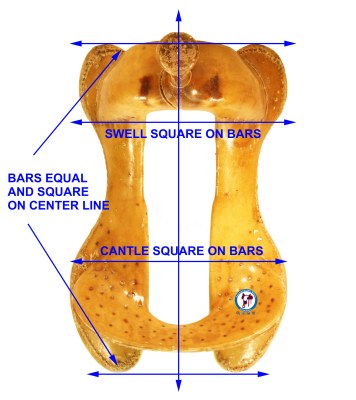 The tree is the foundation of the saddle and must be constructed properly and symmetrically. Any defect in the tree construction will be transmitted to the finished saddle and should be considered a manufacturing defect and automatically a negative saddle fit. The tree is the foundation of the saddle and must be constructed properly and symmetrically. Any defect in the tree construction will be transmitted to the finished saddle and should be considered a manufacturing defect and automatically a negative saddle fit. It is noted that there are times where the saddle maker may order a tree with what would normally be a defect to solve a specific saddle fit situation.
The bars must be mirror images of each other and must be equal and square on the center line of the tree
( see example to the right ). The swell and cantle must also be square on the bars and located at the same position on each bar. Additionally, the angles on the bottom of the swell and cantle must be the same on each side.
It is the responsibility of the tree maker and the saddlemaker to insure that the tree is inspected for any defects prior to building the saddle so the following possible problems are prevented.
The degree of diminished positive level of saddle fit will depend upon each individual situation. Some common situations can be:
a warped tree, bars out of alignment, swell or cantle out of alignment, or swell or cantle angle out of alignment.
|
A warped tree will effect the level of saddle fit. The extent of that effect will depend upon the severity of the warp. Generally warping is not a problem in a molded or composite tree, but is a problem with a tree that has a wood core. Wood will expand or contract in relation the relevant humidity which may cause the wood to warp. Therefore, a wood tree is subject to warping no matter the type of covering.
A wood tree covered by rawhide is more prone to warping. After the wet rawhide is applied to the tree, the rawhide begins to dry and shrink around the tree. This drying process is not uniform and if the tree is not properly stabilized during this curing sequence. the tree can warp.
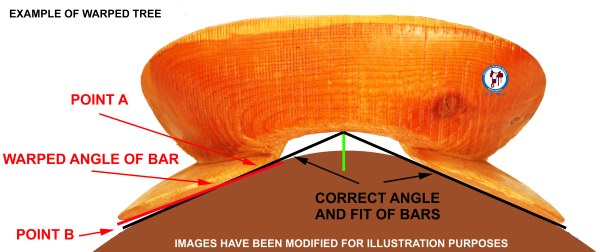 The consequences of a warped tree can be varied depending upon how the tree is warped. In the example to the right, the left bar is warped. The angle of the bar has shifted from the original correct angle ( the black line ) to a new angle( the red line). There is less bearing surface in this example on the back of the left bar. There is more pressure applied at the top portion of the bar ( point A ), while the bottom portion of the bar has no contact with the horse ( point B ). The consequences of a warped tree can be varied depending upon how the tree is warped. In the example to the right, the left bar is warped. The angle of the bar has shifted from the original correct angle ( the black line ) to a new angle( the red line). There is less bearing surface in this example on the back of the left bar. There is more pressure applied at the top portion of the bar ( point A ), while the bottom portion of the bar has no contact with the horse ( point B ). |
The bars of the tree must mirror images of each other and must be equal and square on the center line of the tree. Any misalignment will diminish the level of positive fit and will depend upon each individual situation.
Some examples can be:
one bar ahead or behind the other -- See Example 1
one bar shorter than the other -- See Example 2
one bar tip shorter than the other -- See Example 3
one bar misaligned on the swell or cantle and so on. -- See Examples 4 and 5
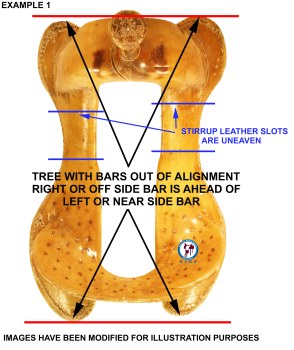   In Example 1 the misalignment of the bars causes the stirrup leather slots to become uneven. The resulting problem is covered in the saddle design and construction section under stirrup leathers
Also, in Examples 1, 2, and 3, when installed the skirts will be crooked and will not sit on the horse square, which may cause the saddle to sit crooked or lopsided. This can put the rider out of balance. As the riders tries to compensate for the out of balance feeling, the vector forces become dynamic and the resulting negative fit could be just the opposite of what would be expected.
Plus, the rigging will be out of alignment if the saddle has in-skirt rigging or the low point of the bar is used to determine the rigging position and resulting problem is covered in the saddle design and construction section under rigging position
 If the bars are not aligned properly on the swell or cantle, the saddle will not fit square on the horse. In (Example 5 ) the right or off side bar is position further down on the swell. Again, the saddle is not sitting on the horse square and balanced. (See Example 6).
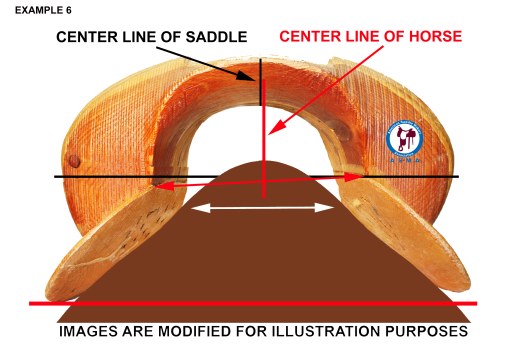  The rider will feel out of balance because the right or off bar is fitting lower down on the horse which also causes the right or off side stirrup leather to be lower than the left or near side stirrup leather. The static load vector will cause more pressure to be applied to the right front of the tree. The rider may feel that they are leaning to the right and forward. Therefore, the rider will try to correct the out of balance situation by applying more pressure on the left or near side stirrup. The load vector now becomes dynamic and more pressure will be applied to the left or near side of the saddle,which is just the opposite of the static load vector. The horse can also react to the dynamic pressure applied by the rider and introduce even more dynamic forces.
|
 The swell and cantle must be square on the bars and located at the same position on each bar.
If the swell is not square on the bars and the swell is used to determine the rigging position, the rigging position will be off as explained in the saddle design and construction section under rigging position. Also, the saddle maker will have a hard time fitting the seat properly.
If the cantle is not square to the bars the rider may feel crooked and out of balance. The rider will attempt to correct the situation by moving around in the seat to find a comfortable position. This motion by the rider can create dynamic forces that may produce negative pressure points in an otherwise positive saddle fit. Again, as with the swell, the saddle maker will have a hard time fitting the seat properly.
|
 The angles on the bottom of the swell and cantle must be the same on each side. The angles on the bottom of the swell and cantle must be the same on each side. The consequences here can be varied depending upon where the angle is off. In the example to the right, the left or off side bar has a different angle than the right or near side bar. The angle of the bar has shifted from the original correct angle ( the green line ) to a new angle( the blue line). There is less bearing surface in this example on the left or off side bar. There is more pressure applied at the top portion of the bar , while the bottom portion of the bar has not contact with the horse. Another problem is that the tree is offset. the center line of the horse and the center line of the tree are not the same. The rider may feel out of balance and attempt to correct their balance creating other dynamic forces further degrading the level of positive fit.
|
NOTE : The images are modified and exaggerated for illustration purposes. The actual measurements and differences are small and therefore are not easily discernable. The profiles of the body types are based on actual profiles.
|
The saddle/tree can fit both the horse and rider, but if the saddle construction is not compatible, then you may have a negative fit. The degree of diminished positive level of saddle fit will depend upon each individual situation. The problem can be as simple as a protruding nail head or as complex as a misaligned rigging, the possibilities are limitless.
Any defect in saddle construction should be considered a manufacturing defect and automatically a negative saddle fit.
It is the responsibility of the saddlemaker to insure that the saddle free of defects during construction and upon completion saddle so the following possible problems are prevented.
Some common situations can be: AGE AND CONDITION -- RIGGING POSITION -- SKIRT LENGTH AND SHAPE -- STIRRUP LEATHERS
|
How the age and condition of a saddle effects saddle fit is unknown
and depends on each individual situation.
The age and condition of a saddle may have an effect on saddle fit. A good example is a rider wanting to use their Grandfather's saddle. As stated before, the conformation of the horse is always changing. Saddle makers and tree makers are constantly modifying their bar patterns and tree measurements to conform to the ever changing conformation of horses. Therefore, a saddle made 60 to 70 years ago will automatically present a possible saddle fit problem when it is being used on the present day horse conformation.
As far as condition of a saddle is concerned the possible problems with saddle fit can be many. Some examples could be:
Loss of pile of the sheepskin, causing the saddle to sit lopsided on the horse.
The rigging leather has stretched, causing the rigging to be misaligned.
The skirts and not firmly attached to the tree, causing unwanted movement of the saddle.
|
The position or placement of the rigging on the saddle will effect saddle fit.
There are 5 basic rigging positions for western saddles.
The rigging position is determined by the use and type of saddle along with the conformation of the horse. Currently the 7/8th position is the most popular. Generally, as the rigging position moves towards the front of saddle (the full position) the saddle will move back on the horse and as the rigging position moves towards the back of the saddle (the center position) the saddle will move forward on the horse. If the rigging position is incompatible, the level of positive or negative saddle fit will depend upon the individual situation.
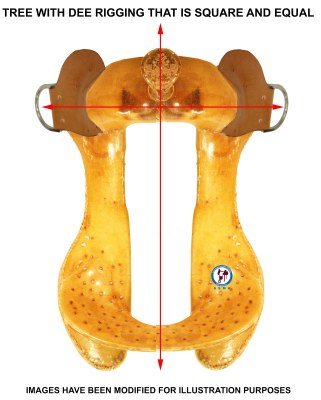 As with the tree bars, the riggings must be mirror images of each other and must be equal and square on the center line of the tree ( see example to the right ). As with the tree bars, the riggings must be mirror images of each other and must be equal and square on the center line of the tree ( see example to the right ).If the rigging is not square and equal no matter what style of rigging used, when the saddle is cinched-up the pressure or vector forces want to bring the saddle into equilibrium causing the saddle to twist on the horse's back.
Any mis-alignment will diminish the level of positive fit and will depend upon each individual situation. Also, the only solution to correct the problem is by re-rigging the saddle and that may or may not be economical.
Some examples can be:
swell mis-aligned -- See Example 1
dee rigging mis-aligned -- See Example 2
in-skirt rigging mis-aligned -- See Example 3
saddle with in-skirt rigging properly aligned but skirts are mis-aligned -- See Example 4
Example 1
In this example, the swell is not square on the bars of the tree. The off or right side is forward of the near of left side (see Example 1). (NOTE: This tree should have been rejected as defective and not used.) With the off or right side rigging ahead of the near or left side rigging, when the saddle is cinched-up the, the saddle will want to twist on the horse's back in a clock wise motion (see Example 1-A) ( NOTE: If the situation is reversed the twist would be counter clock wise. ) as the static vector forces bring the saddle into equilibrium. The result is that pressure points occur at the front of the saddle on the near or left side of the saddle and at the back of the off or right side if the saddle, as indicated in Example 1-A. Also, once in motion, this mis-alignment may be transmitted to both the rider and horse. The horse and rider may try to compensate and load vector now becomes dynamic which can cause additional possible pressure points.
  Example 2
In this example, the dee rigging is mis-aligned. The off or right side rigging dee is set forward of the near or left rigging dee.
As with Example 1, the off or right side is forward of the near of left side (see Example 2). With the off or right side rigging being ahead of the near or left side rigging, when the saddle is cinched-up the, the saddle will want to twist on the horse's back in a clock wise motion (see Example 2-A) ( NOTE: If the situation is reversed the twist would be counter clock wise. )as the static vector forces bring the saddle into equilibrium. The result is that pressure points occur at the front of the saddle on the near or left side of the saddle and at the back of the off or right side if the saddle, as indicated in Example 2-A. Also, once in motion, this mis-alignment may be transmitted to both the rider and horse. The horse and rider may try to compensate and load vector now becomes dynamic which can cause additional possible pressure points.
  Example 3
 In this example, the in-skirt rigging is mis-aligned. The off or right side in-skirt rigging dee is set behind the near or left side in-skirt rigging dee. With the off or right side in-skirt rigging being behind the near or left side in-skirt rigging, when the saddle is cinched-up the, the saddle will want to twist on the horse's back in a counter clock wise motion ( NOTE: If the situation is reversed the twist would be clock wise.) as the static vector forces bring the saddle into equilibrium. The result is that pressure points occur at the front of the saddle on the off or right side of the saddle and at the back of the near or left side of the saddle. Also, once in motion, this mis-alignment may be transmitted to both the rider and horse. The horse and rider may try to compensate and load vector now becomes dynamic which can cause additional possible pressure points.
Example 4
 In this example, the in-skirt rigging is in the proper position but the off or right skirt is mis-aligned. This causes the off or right in-skirt rigging dee to be positioned behind the near or left side in-skirt rigging dee. With the off or right side in-skirt rigging being behind the near or left side in-skirt rigging, when the saddle is cinched-up the, the saddle will want to twist on the horse's back in a counter clock wise motion (NOTE: If the situation is reversed the twist would be clock wise.) as the static vector forces bring the saddle into equilibrium. The result is that pressure points occur at the front of the saddle on the off or right side of the saddle and at the back of the near or left side of the saddle. Also, once in motion, this mis-alignment may be transmitted to both the rider and horse. The horse and rider may try to compensate and load vector now becomes dynamic which can cause additional possible pressure points.
|
The skirts of the saddle can effect the level of positive saddle fit.
The length of the skirts can effect saddle fit if the length is to long for the conformation of the horse. In general, the area available for a saddle to fit properly on a horse's back is from the back of the shoulder and in-front of the leading point of the hip (see FIGURE 1). If the skirts of the saddle extend past these points the horse may feel pressure or restriction and thus inhibit the movement of the shoulder or hip. The horse can react to this restriction in movement and introduce even more dynamic forces further degrading the level of positive saddle fit and correspondingly the horse’s performance. It has been observed that this problem is increasing with the development of bloodlines that are more compact resulting in a shorter back.
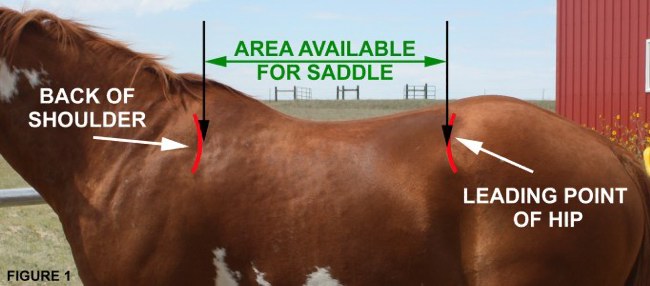  In FIGURE 2 a saddle with "square" skirts fits within the "available area" for the saddle on the horse.
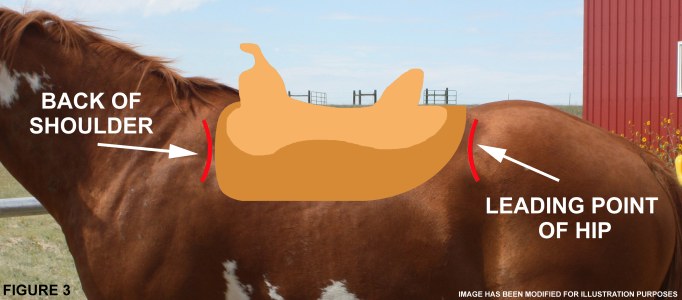 In FIGURE 3 a saddle with "round" skirts fit within the "available area" for the saddle on the horse.
In FIGURE 4 the skirts extend past the leading point of the hip (see FIGURE 4-A). When the horse is in motion the point of the hip will make contact with the skirts. How the horse reacts to this contact of pressure will depend upon the individual horse. It could not react at all, the horse may adjust it's stride, or you could have an 8 second ride at the National Finals. Also, the contact with the leading point of the hip may result with a rub spot and loss of hair. Even with a pad this contact will be transmitted to the horse.
 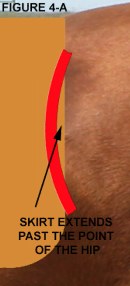  FIGURE 5 illustrates a saddle with skirts the same length as the saddle in FIGURE 4 but that are rounded. In this case by rounding the skirts the saddle fits within the "available area" and fits. Rounded skirts will fit more horses than square skirted saddles. Maybe this is why the wade saddle that the buckaroos use have rounded skirts. FIGURE 5 illustrates a saddle with skirts the same length as the saddle in FIGURE 4 but that are rounded. In this case by rounding the skirts the saddle fits within the "available area" and fits. Rounded skirts will fit more horses than square skirted saddles. Maybe this is why the wade saddle that the buckaroos use have rounded skirts. When fitting a saddle some use the following guide line: there is a tuft or swirl of hair just in front of the point of the hip (see FIGURE 6). If the skirts cover up this tuft of hair then the skirts could be to long for the horse.
 The bars of the tree are designed and shaped to conform the contour of the horses back. For the saddle to fit properly the skirts need to be formed or molded to the shape of the tree bars(see FIGURE 7). Saddle makers refer to this as "blocking" the skirts. In this example there is a little gap at the top of the bar, but would be with acceptable limits of positive saddle fit.
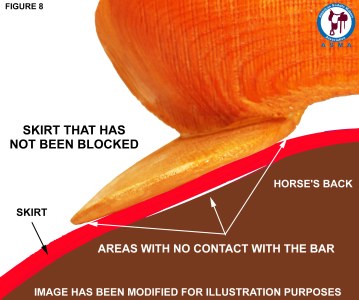 If the skirts are not blocked or properly blocked the result may be a negative saddle fit or a decreased level of positive saddle fit
(see FIGURE 8). FIGURE 8 illustrates that three portions of the bar do not have contact with the horses's back. While over time and with use the skirts will block themselves to some extent, but always at a degraded level of positive saddle fit versus properly blocked skirts as illustrated in FIGURE 7.
Not only do the skirts need to be blocked to the contour of the tree bars, they need to be shaped to follow the shape of the horse's back at both the front and back. FIGURE 9 illustrates a properly shaped skirt at the withers and FIGURE 10 illustrates a improperly shaped skirt at the withers, which can cause a rub spot and inhibit the movement of the horse's shoulder. While the rub spot may not become a sore spot, the restriction of movement will decrease the horse's performance and thus a decreased positive level of saddle fit.
  FIGURE 11 illustrates a properly shaped skirt at the back and FIGURE 12 illustrates a improperly shaped skirt. This situation somewhat common, which results in a rub line on the horse's back that corresponds to the back end of the skirts. How this effects the positive level of saddle fit will depend upon the individual situation, but the positive level of saddle fit will be decreased no matter what.
   Another area where the skirts can effect saddle fit is the cantle gullet. The cantle gullet is designed to provide relief for the horse's back bone and air flow. In FIGURE 13 the skirts have been blocked around the tree bars, but not up into the cantle gullet. A pressure point may be created between point A and point B, once the load vector is applied.
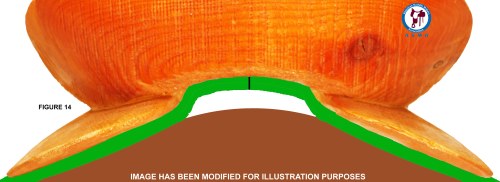 FIGURE 14 illustrates skirts that are properly blocked into the cantle gullet providing relief for the back bone and air flow. It is noted that if the skirts are laced together and that if the lacing is not done properly the result will be similar to FIGURE 13.
|
The stirrup leathers must be mirror images of each other as to length, the position and spacing of holes for the buckles, and position on the bars of the tree and if not both the saddle and rider will be out of balance.
If this is the case in a new saddle, it should be considered a manufacturing defect and returned. On an existing saddle a qualified saddle maker can repair the problem.
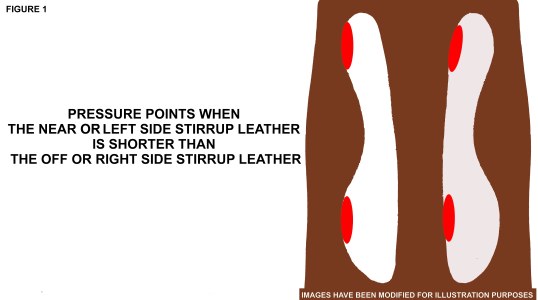 With stirrup leathers that are not equal in length, the rider will lean in the direction of the longer stirrup leather and feel lopsided and out of balance. The rider will attempt to become balanced by applying more pressure on the short stirrup causing the saddle to shift out of alignment. The result will be that more pressure will be applied to the bottom of the tree bars on the side of the short stirrup towards and the top of the bars on the side with the long stirrup (see FIGURE 1). Also, once in motion, this mis-alignment may be transmitted to the horse. The horse may try to compensate and load vector now becomes dynamic which can cause additional possible pressure points. With stirrup leathers that are not equal in length, the rider will lean in the direction of the longer stirrup leather and feel lopsided and out of balance. The rider will attempt to become balanced by applying more pressure on the short stirrup causing the saddle to shift out of alignment. The result will be that more pressure will be applied to the bottom of the tree bars on the side of the short stirrup towards and the top of the bars on the side with the long stirrup (see FIGURE 1). Also, once in motion, this mis-alignment may be transmitted to the horse. The horse may try to compensate and load vector now becomes dynamic which can cause additional possible pressure points. In the case of a saddle where the stirrup leathers are not positioned properly on the tree bars the saddle will be out of balance when used by the rider. In this example the off or right side stirrup leather is forward of the near of left side stirrup leather (see Example 1). With the off or right side stirrup leather ahead of the near or left side stirrup leather, when the rider applies pressure to the stirrups, the saddle will want to twist on the horse's back in a clock wise motion (see Example 1-A) ( NOTE: If the situation is reversed the twist would be counter clock wise. ) as the static vector forces bring the saddle into equilibrium. The result is that pressure points occur at the front of the saddle on the near or left side of the saddle and at the back of the off or right side if the saddle, as indicated in Example 1-A. Also, once in motion, this mis-alignment may be transmitted to both the rider and horse. The horse and rider may try to compensate and load vector now becomes dynamic which can cause additional possible pressure points.
  |
NOTE : The images are modified and exaggerated for illustration purposes. The actual measurements and differences are small and therefore are not easily discernable. The profiles of the body types are based on actual profiles.
|
e-mail mailto:info@saddlemakers.org
Copyright 2005 - 2016 American Saddle Makers Association, Inc.

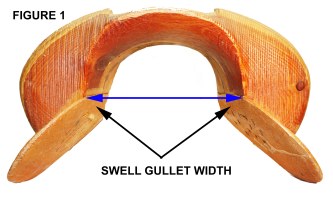
 Another inherent problem with saddle fit is that all the tree measurements are based on the bare tree. Once leather is added to the tree, one can not take an accurate measurement as the reference points can no longer be determined. A good example is the swell gullet width measurement. The swell gullet width is measured from the point where the top of the bar meets the bottom of the swell and across to the same point on the other side ( see Example A, a swell width of 6 1/2" ). Once the skirts are installed on the tree, this reference point is covered up by the gullet cover, swell cover, seat jockey, and skirts, etc. ( see Example B ). Therefore, with the inability of determining the actual reference points ( Red arrows in Example C ), one must approximate the reference points. Thus the swell gullet measurement will be approximate. Depending upon the reference point used ( see Example D ), the difference can be up to 2" ( 5 1/2" at Point A to 7 1/2" at Point D ).
Another inherent problem with saddle fit is that all the tree measurements are based on the bare tree. Once leather is added to the tree, one can not take an accurate measurement as the reference points can no longer be determined. A good example is the swell gullet width measurement. The swell gullet width is measured from the point where the top of the bar meets the bottom of the swell and across to the same point on the other side ( see Example A, a swell width of 6 1/2" ). Once the skirts are installed on the tree, this reference point is covered up by the gullet cover, swell cover, seat jockey, and skirts, etc. ( see Example B ). Therefore, with the inability of determining the actual reference points ( Red arrows in Example C ), one must approximate the reference points. Thus the swell gullet measurement will be approximate. Depending upon the reference point used ( see Example D ), the difference can be up to 2" ( 5 1/2" at Point A to 7 1/2" at Point D ).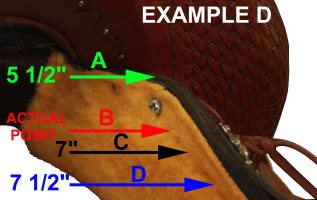
 When a tree is placed on a flat surface and the tree rocks because one or two the low points of the bar do not touch the surface then the tree may be warped. Note: This also may be caused by a bar that is not the same as the other or the way the covering was applied, etc
When a tree is placed on a flat surface and the tree rocks because one or two the low points of the bar do not touch the surface then the tree may be warped. Note: This also may be caused by a bar that is not the same as the other or the way the covering was applied, etc